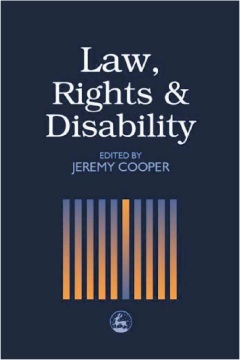
BOOK
Law, Rights and Disability
Lisa Waddington | Belinda Schwehr | Mary Holmes | Clare Picking | Suzy Braye | Mairian Corker | Jeremy Cooper
(2000)
Additional Information
Book Details
Abstract
This comprehensive volume assesses the relationship between legal rights and disability and the effect of law, legal process and third party professional intervention on the lives of people with disabilities. Stressing the crucial role played by disabled people themselves in fulfilling the promise of the worldwide rights movement, the chapters examine this relationship across a variety of themes, stressing the legal elements of each issue, and the extent to which law can assist in strengthening individual rights in that area. The contributors, who are all either academics or other professional experts in their field, write in a jargon free accessible style. The volume will be of interest to lawyers, human rights activists, health care professionals and to disabled people generally.
The main areas covered in the volume are:
* new perspectives on working in partnership with disabled people;
* the changing attitudes to the rights of people with disabilities across the globe;
* improvements to the rights of disabled people through legal process, using national and international law;
* an examination of the rights and entitlement of disabled people to community care, housing, employment, education, and special services for children;
* disabled people and mental health law;
* messages from disability research for law, practice and reform implications for research.
I found this book to be impressive in its comprehensive coverage, in its ability to address very real and current issues and in the way that it is unafraid to address bad practice. I would thoroughly recommend this book to health and social work practitioners and to students.
The British Journal of Developmental Disabilities
This book describes the law relating to the rights of people with disabilities as defined in international, European and UK law. However, it does much more than this. It sets these rights and laws in the context of a social model of disability, where the impairment becomes disabling as a result of the barriers in society which limit participation in day-to-day activities. These barriers can be physical, financial or attitudinal. This is linked with a rejection of the medical model, where the focus on the physical or intellectual limitations is believed to lie within the individual.
Royal College of Speech and Language Therapists Bulletin
This book describes the law relating to the right of people with disabilities as defined in international, European and U.K. law. However it does much more than this. It sets these rights and laws in the context of a social model of disability, where impairment becomes disabling as a result of the barriers in society which limit participation in many day-to-day activities. The book is aimed at social and healthcare professionals and cites research throughout showing that many within this group still hold attitudes, which restrict rather than enable participation. It is interesting background reading and useful to have as a reference for times when we need access to information about our clients' rights.
Bulletin
The focus on law in context is to be greatly welcomed, especially in relation to a wider international framework... this book should be included on booklists for students in social work since it addresses disability and the law more widely than conventional legal texts and therefore fills an important gap in the literature.
Social Work Education
This book sets out to assess the effect of law, legal process and third party professional intervention on the lives of people with disabilities. Stressing the crucial role played by disabled people themselves in fulfilling the promise of the worldwide rights movement, the volume stresses the extent to which law can assist in strengthening individual rights.
ELPI
This text takes a very comprehensive look at the relationship between legal "rights" and disability, and the effects of the law and the legal process on people with disabilities. As well as taking into account the role of people with disabilities themselves, rather than just the professionals and third parties involved in securing justice for disabled people, the various chapters in the book address a variety of key themes. These include: "working in partnership" with disabled people, and the interventions care and other agencies engage in; changing attitudes towards disability; specific areas of "rights" to community care, housing employment, education, and special services in response to needs; mental health law; and the research into law, practice, and reform programmes.
Welfare Benefits
